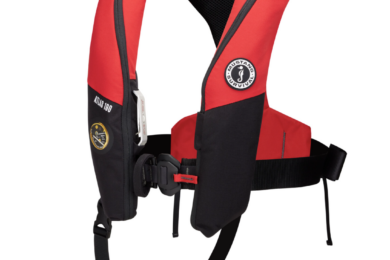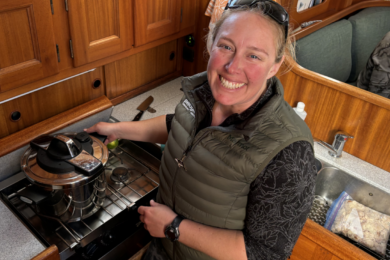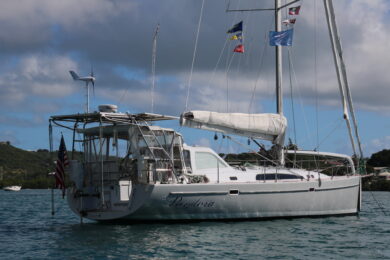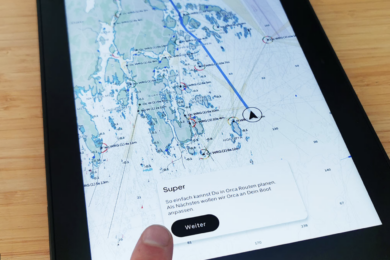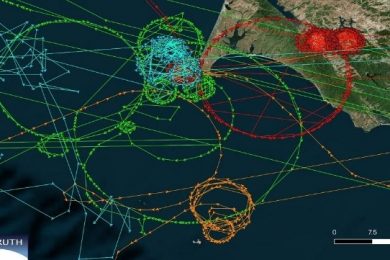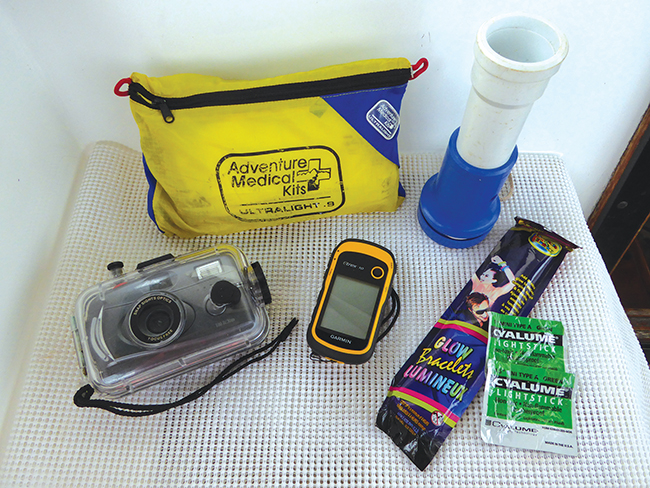(published October 2017)
Imagine that your worst nightmare has come true; a catastrophic equipment failure, irreparable damage due to a collision at sea or human error puts your vessel in peril. You find yourself getting ready to abandon ship, but how prepared are you?
Last year in western Canada there was a massive, quick-spreading wild fire that destroyed a whole city in under an hour. Many residents had fewer than 20 minutes to grab possessions and abandon their homes to the blaze. As I sat a half a world away onboard Kate reading about the tragedy what held my attention were the stories that detailed what items people grabbed when fleeing; ice skates, kitchen appliances, a few items of clothing. It made me pause and wonder, “How would I react in a sudden emergency situation that forced us to flee our home and what items would I grab on the way out?” Thankfully I didn’t have to wonder too long; sitting right next to the companionway was our ditch bag.
PACKING FOR THE IMPROBABLE
The chances of you finding yourself in a situation that requires you to abandon your vessel are slim, but that doesn’t mean that you shouldn’t be prepared. Although the life raft has long been considered your best chance of survival in an abandon ship situation it is the ditch bag that holds all the necessary tools for a speedy recovery. From high tech electronic gadgets to signal devices that have been around since the golden age of sail, what you pack could mean the difference between life and death, so it is worth considering what goes into your ditch bag.
 EPRIB – Emergency Positioning Radio Indicating Beacon
EPRIB – Emergency Positioning Radio Indicating Beacon
Standard kit on most boats this emergency beacon is often mounted in an easy-to-reach spot near the companionway or in the cockpit, however it can also be stored in your ditch bag. It can be activated either manually or automatically if the vessel and its crew are in distress.
When activated an EPRIB broadcasts a coded message on 406MHz, the international emergency communications frequency, for at least 48 hours. Using a global satellite network authorities are notified of your location and the unique information provided when you register the beacon allows them to identify the exact vessel that is in distress.
A standard EPRIB can locate your specific location +/- 3NM; however models that are equipped with a GPS are accurate to +/- 50m. Some EPRIBs also broadcast simultaneously on 121 MHz, a lower frequency that can be picked up by a rescue vessel or aircraft in close range, and have a strobe light to attract visual attention.
An EPRIB is your first line of defense and communication when trouble strikes. No vessel should be without one.
SART- Search And Rescue Transponder
Not as popular as the EPRIB, a Search and Rescue Transponder uses radar frequency. Designed to be activated when visual contact is made with a nearby vessel a SART will emit a signal that appears on a X-band radar screen as 12 consecutive blips pointing to your location. This distinct radar signature is designed to grab the attention of the radar operator, allowing them to pinpoint your location.
Considered secondary to the popular EPRIB, a SART is your primary means of communicating with a potential nearby rescue vessel, long after the EPRIB battery goes flat. Unlike an EPRIB there is no need to register a SART, so it can be carried from vessel to vessel, handy if you are a boat hopping crewperson.
When active a SART emits both audio and visual cues to alert the user it is transponding. Like any radar equipment the higher the SART is located the further it’s broadcasting potential, so it is often recommended that the device is raised on a pole or, at the very least, held aloft.
Inflatable Radar Reflector
An inflatable life raft, constructed almost entirely out of PVC, has no hard edges or reflective surfaces that easily show up on radar. In fact the only large metal object onboard is the tank used to inflate the raft, which, when the raft is upright, is located underwater. This means that although your life raft is designed to be highly visible it can only be seen by the human eye, not the machines we so frequently rely on.
 An ideal solution to this problem is to carry an inflatable radar reflector like the EchoMax EM2301. No bigger than a book when deflated it is compact and light weight, adding just one and a half pounds to your ditch bag. Visible on radar due to the DuPont metallized, lacquered and spun-bonded fabric panels that are housed in the inflatable PVC structure, you don’t have to worry about sharp edges that might puncture your life raft. Approved by the Royal Ocean Racing Club, as well as the U.S. and Canadian Coast Guard, EchoMax inflatable radar reflectors come with a test certificate to comply with the stringent regulations of many round the world rallies and are now standard kit on the Golden Globe race boats.
An ideal solution to this problem is to carry an inflatable radar reflector like the EchoMax EM2301. No bigger than a book when deflated it is compact and light weight, adding just one and a half pounds to your ditch bag. Visible on radar due to the DuPont metallized, lacquered and spun-bonded fabric panels that are housed in the inflatable PVC structure, you don’t have to worry about sharp edges that might puncture your life raft. Approved by the Royal Ocean Racing Club, as well as the U.S. and Canadian Coast Guard, EchoMax inflatable radar reflectors come with a test certificate to comply with the stringent regulations of many round the world rallies and are now standard kit on the Golden Globe race boats.
Handheld GPS
With the variety and economy of models on the market today it is silly not to include a small handheld GPS in your ditch bag. Not only will you be able to communicate your exact location to potential rescuers you can use it to determine your set and drift, which will take the guess work out of a contingency sail plan.
Handheld or Emergency VHF
Although most boats carry a waterproof, handheld VHF for daily use it is important to remember to keep the batteries charged if it will be a part of your ditch bag. An alternative is to have a dedicated emergency VHF in your kit, ensuring you always have a means of close range communication during an emergency.
If you choose to use your daily handheld radio as part of your emergency ditch bag investing in an inexpensive waterproof bag for it is good insurance that it stays operational even during heavy weather. Keeping a spare battery fully charged is also a good idea.
Satellite Phone
Many sailors carry a satellite phone for emergency purposes but their high cost, both for the equipment and airtime can be discouraging. Newer devices, with lower price points, like the SPOT or the more recent InReach are quickly becoming popular alternatives. However, nothing beats making instant two-way communication. You can not only relay important details about your situation but also ask questions, which may be lifesaving during a medical emergency.
As we have tragically seen in the recent past not all service providers are created equal. Test your phone periodically to make sure your service is still active and there is credit on the account. Not designed specifically for marine use it is recommended that you invest in a waterproof box to protect your satellite phone while not in use.
Medical Kit
A basic medical kit is standard equipment in a life raft but extra medical supplies will never go astray. By including a medical kit in your ditch bag you can be assured that supplies for any existing medical conditions are with you, including necessary daily prescription medications. One invaluable item that should be included in your medical kit is a space blanket or two. Super compact and light weight these foil-like blankets are designed to conserve body heat, important when hypothermia due to exposure in water is a serious consideration.
This is also a great place to stash an extra pair of eyeglasses or contact lenses, which, if you have a heavy prescription, could mean the difference between living in a blur for a few days and being able to read fine print instructions. Like the onboard medical kit you should inspect the contents regularly, check expiration dates and replace items as needed.
 Noise Maker, Heliograph and Vee Sheet
Noise Maker, Heliograph and Vee Sheet
These low-tech solutions may seem old school in today’s digital world but they could prove essential when trying to get the attention of a passing ship or aircraft. The glint of sun off a heliograph or the conspicuous orange of a vee-sheet will quickly catch the eye of passersby. The ‘blart’ of a simple to use noisemaker could prevent an accidental collision between you and your rescuers in fog or inclement weather. You never have to worry about charging batteries or remembering to use complicated equipment during times of stress. These easy to use safety devices are still a must have in your ditch bag.
Manual Water Filter
Humans can only survive for three days without clean drinking water, which makes carrying a manual water filter a no brainer. In fact, during the last Volvo Ocean Race team Dongfeng found a use for their emergency water filtration system when their onboard desalinator required a repair that took 12 hours to complete. Although keeping up with the water demands of the whole crew at sea was a laborious task this simple piece of equipment kept them in the race.
Now affordable and widely available at camping supply stores these easy to operate devices ensure that you have safe drinking water wherever you end up. Make sure to pack extra filters and spares, there won’t be a store handy when you need to use one of these.
 Extra Food and Water Rations
Extra Food and Water Rations
Like the extra medical supplies, carrying extra food and water rations off the boat with you is never a bad idea. When we last had our life raft serviced we chose to keep the water rations that were replaced to use as additional water in our ditch bag as they are compact, portioned survival rations but you can simply stock a reserve of bottled water in case of emergency. We also carry a jar of natural peanut butter and a bottle of honey. The peanut butter is an easy to eat food that is high in fats and energy, perfect for eating alone, masking flavors like fish or making those dusty ration biscuits palatable. Honey is not only great to dissolve in water to give you a boost, it can be used to treat minor cuts and burns. You could also consider packing some high quality energy bars or gels, items that are small, easy to eat and do not require cooking.
Passports & Boat Documents
It should be general practice to store the passports of all people on board together , this includes any visiting crew or guests. Keep these and other important documents such as boat registration and insurance papers in a waterproof box in or close to your ditch bag. It is also a good idea to include some cash or travellers cheques so that you are able to pay for hotels and purchase clothing or plane tickets home once you are rescued.
Cheap and Cheerful Extras
There are various other bits that I keep in our ditch bag, things that are not essential but that could come in handy. For instance inexpensive glow sticks, when worn, allow you to quickly identify the location of each crew member and a small waterproof flashlight that could be used as a signal light. I carry a waterproof camera so that I might be able to record the events, which could come in handy for an insurance claim. To conserve space I allow only a small Ziploc bag of these nonessential extras.
Testing, Testing
Investing time in your ditch bag now means that you’ll have everything on hand when an emergency strikes. However, what you pack is only as important as maintaining the items that you choose to carry. Your EPRIB, SART and other electronic devices should be tested annually and/or before you set out on passage. You will find the manufacturer instructions on how to test each device next to the activation switch. A visual and audio alarm will indicate if the device is functioning properly or if it needs to be serviced. For items like a small GPS that use regular batteries be sure to pack spares.
If you have guests onboard for an extended cruise, or if you take additional crew for passage, it is a good idea to familiarize them with the location and contents of your ditch bag. Although they may be seasoned sailors they may not be acquainted with your vessel, safety procedures or the type of gear you carry. Remember you could be relying on this person to save your life.
No sailor likes to think about abandoning their vessel but a prudent mariner must consider, and prepare for, all possibilities. As the old saying goes, “Better looking at it than looking for it.”
Heather Francis is from Nova Scotia, Canada and for over a decade has worked and lived on boats throughout the world. In 2008 she and her Aussie partner, Steve, bought Kate, a Newport 41’, and have been sailing ever since. They are currently in the Philippines. You can follow their adventures at www.yachtkate.com.


